Prechemotherapy Assessment of Neutropenic Risk
Chemotherapy-induced febrile neutropenia (FN) predisposes patients to life-threatening infections and typically requires hospitalization. The goal was to investigate whether a risk assessment tool aligned with national guidelines could help identify patients at risk of FN and reduce FN-related hospitalizations. Beginning in October 2004, oncology nurses applied the new risk assessment tool to all patients initiating chemotherapy or a new regimen. Patients at risk for FN received prophylactic colony-stimulating factor. Charts for 189 patients receiving chemotherapy in fiscal year 2005 (FY05) were compared with charts of 155 patients receiving chemotherapy in FY04, before the tool was implemented. The incidence of FN-related hospitalization declined by 78%, from 9.7% in FY04 to 2.1% in FY05 (P = .003). Total hospital days decreased from 117 to 24. Routine systematic evaluation by oncology nurses improves recognition of patients at risk of FN and substantially reduces FN-related hospitalization.
Chemotherapy-induced febrile neutropenia (FN) predisposes patients to life-threatening infections and typically requires hospitalization. The goal was to investigate whether a risk assessment tool aligned with national guidelines could help identify patients at risk of FN and reduce FN-related hospitalizations. Beginning in October 2004, oncology nurses applied the new risk assessment tool to all patients initiating chemotherapy or a new regimen. Patients at risk for FN received prophylactic colony-stimulating factor. Charts for 189 patients receiving chemotherapy in fiscal year 2005 (FY05) were compared with charts of 155 patients receiving chemotherapy in FY04, before the tool was implemented. The incidence of FN-related hospitalization declined by 78%, from 9.7% in FY04 to 2.1% in FY05 (P = .003). Total hospital days decreased from 117 to 24. Routine systematic evaluation by oncology nurses improves recognition of patients at risk of FN and substantially reduces FN-related hospitalization.
On a daily basis, oncology nurses manage patients at risk for chemotherapy-induced neutropenia, which has been recognized to predispose cancer patients to infection.[1] Neutropenia blunts the body's inflammatory response to invasion by bacterial or fungal pathogens so that fever may be the only sign of infection.[2] Patients with fever and neutropenia, or febrile neutropenia (FN), are 50% more likely to experience a recognized or occult infection than those without febrile neutropenia.[2]
Because of the reduced number of neutrophils, infection can progress rapidly in patients with FN; this can result in life-threatening complications such as multiorgan failure or severe sepsis. The Infectious Diseases Society of America recommends aggressive treatment for the majority of patients with FN, which typically includes hospitalization for prompt administration of intravenous antibiotics and monitoring.[3]
Febrile Neutropenia Hospitalizations
A recent analysis of hospital discharge databases shows that more than 60,000 cancer patients in the United States require hospitalization for FN each year, which results in an estimated inpatient mortality rate of 6.8%.[4] Another independent analysis showed that mortality associated with FN-related hospitalizations was 9.5% for the overall population and more than 20% for patients who have more than one major comorbidity.[5] Hospitalization also interferes with the ability to maintain chemotherapy dose and schedule; increasing evidence suggests that dose reductions and treatment delays can compromise long-term survival in patients with potentially curable malignancies.[6-13]
In addition, FN-related hospitalization impairs patient quality of life, as documented by studies that used validated questionnaires.[14-16] Patient concerns generally include separation from family, invasive diagnostic and treatment procedures, the need to adhere to strict guidelines to reduce the risk of infection, and the potential for infection, chemotherapy failure, and death.[17]
The prevention of FN clearly benefits patients. A number of studies[18-23] and a recent meta-analysis[24] have shown that primary prophylaxis with granulocyte colony-stimulating factor (G-CSF)-that is, G-CSF given in all cycles of chemotherapy starting in the first cycle-reduces the incidence, severity, and duration of FN. Prophylactic G-CSF can also reduce the incidence of dose reductions and treatment delays[24-26] and there is evidence that it reduces the risk of infection-related mortality.[24]
Available Guidelines
Recent evidence-based guidelines have described the rationale and benefit of managing neutropenia with prophylactic G-CSF. Three national and international guidelines for the use of G-CSF have been developed by the National Comprehensive Cancer Network (NCCN),[27] the American Society of Clinical Oncology (ASCO),[28] and the European Organisation for Research and Treatment of Cancer (EORTC).[29] These guidelines concur that patients should receive primary prophylaxis with CSF when the risk of FN with a chemotherapy regimen is approximately 20% or higher. Other factors to be considered in determining risk of FN are patient-related factors (eg, age, performance status, comorbidities), treatment history (eg, previous neutropenia), disease characteristics (eg, advanced or uncontrolled cancer), and treatment intent (curative vs palliative).
At our clinic, orders for G-CSF are written by midlevel providers (nurse practitioners and physician assistants) within their scope of practice. Completed chemotherapy orders, which include orders for prophylactic growth factors, require the co-signature of an oncologist. Because of their close, continuing communication with patients, nurses are in an ideal position to assume a role in neutropenic assessment prior to the initiation of chemotherapy, as well as before all subsequent cycles. The nursing staff at the Puget Sound Veterans Affairs (VA) Medical Center Cancer Care Clinic implemented a risk assessment tool to identify patients at risk for FN, and therefore are candidates for prophylactic G-CSF. The primary objective of this continuous quality improvement project was to minimize the incidence of hospitalizations due to FN (Figure 1).
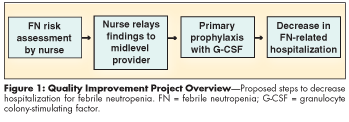
Chart Review Design and Patient Eligibility
The nursing staff reviewed the nursing and medical literature on chemotherapy-induced neutropenia and collected available FN risk assessment tools. We decided to use a tool available from a pharmaceutical company (Figure 2) because of its completeness and conformity with the most recent data available at the time. The project was approved by the nursing supervisor.
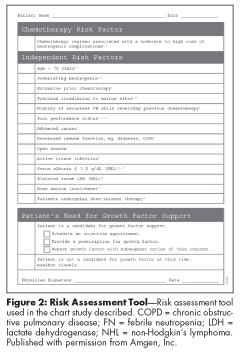
The effect of implementation of the risk assessment tool was evaluated via a review of chart records. Patient outcomes in fiscal year 2004 (FY04: October 1, 2003, to September 30, 2004), before the tool had been implemented, were compared with outcomes in FY05 (October 1, 2004, to September 30, 2005), after the tool had been used routinely. All cancer patients initiating chemotherapy or undergoing a regimen or protocol change were evaluated regardless of tumor type or stage. The following information was collected: age, sex, cancer type, chemotherapy regimen, G-CSF use, hospitalization for FN, length of hospitalization, and, for patients treated in FY05, patient- and disease-specific risk factors for FN. To determine hospitalization for FN, we collected records on all inpatient admissions to the Puget Sound VA Medical Center that were coded for FN (ICD-9 code 288.0) and selected those for patients treated in the Cancer Care Clinic. Febrile neutropenia was defined as absolute neutrophil count (ANC) ≤ 500/µL and temperature ≥ 100.5°F.
Upon completion of the risk assessment tool by the nursing staff, a midlevel provider decided whether to order G-CSF and, if so, wrote the order directly on the chemotherapy order form. All orders for chemotherapy and G-CSF were approved and signed by the oncologist according to the usual practice in the Cancer Care Clinic.
Consistent with published guidelines, patients routinely received G-CSF starting in the first cycle of chemotherapy if the planned chemotherapy regimen was associated with a risk of FN ≥ 20%. In addition, the assessment tool was used to guide evaluation of the need for G-CSF based on patient- and disease-specific risk factors for patients who were treated with chemotherapy regimens associated with a < 20% risk of FN.
Eligible patients received filgrastim (Neupogen) or pegfilgrastim (Neulasta) according to the package insert. Most patients were scheduled for weekly follow-up, including physical examination and blood tests. Most patients who had an ANC below 1,500/µL between cycles of chemotherapy were given G-CSF as secondary prophylaxis in subsequent cycles.
All patients were educated about common side effects associated with chemotherapy and were cautioned to contact the clinic if any of them occurred. In particular, patients were instructed about how and when to take their temperatures to monitor for FN. In addition, patients who were candidates for G-CSF were taught to self-inject the growth factor, which is standard of care in the VA system. The nursing staff showed patients a video about subcutaneous self-injection, provided printed instructions, and supervised the patients in giving themselves a subcutaneous saline injection.
Descriptive statistics were used to analyze all variables. The rates of FN-related hospitalization before and after implementation of the risk assessment tool were compared using the Fisher exact test.
Study Results
A total of 189 patients were evaluated with the risk assessment tool during FY05, including 88 in the first 6 months after its implementation and 101 in the second 6-month period. The comparison group comprised 155 patients treated in FY04, prior to use of the tool. Demographic characteristics are shown in Table 1. Patients treated in FY04 and FY05 were fairly well-matched and representative of the patient population treated at the VA.
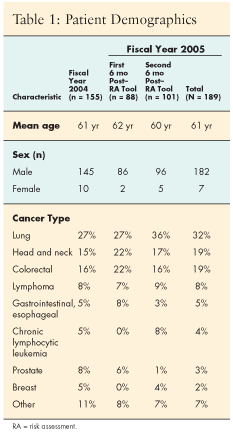
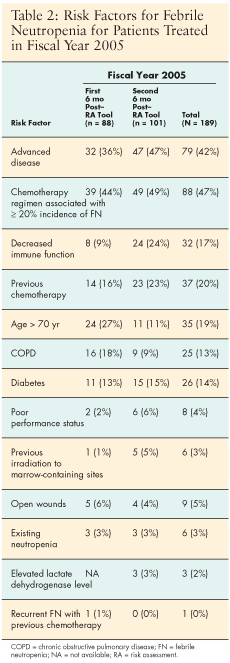
Table 2 shows the percentages of patients assessed and treated during FY05 who were found to have risk factors for FN. Eligible patients received prophylactic G-CSF. Implementation of the risk assessment tool significantly reduced the number of hospitalizations for FN by 78%, from 9.7% (15/155) in FY04 to 2.1% (4/189) in FY05 (P = .003) (Figure 3). The total number of hospital days also decreased, from 117 in FY04 to 24 in FY05. The average length of hospital stay decreased from 7.8 days in FY04 to 6 days in FY05.

In FY04, prior to the implementation of the risk assessment tool, prophylactic G-CSF support was given to 6% (9/155) of all patients and 21% (9/43) of patients who were treated with chemotherapy regimens associated with a risk of FN ≥ 20%. In FY05, after the routine use of risk assessment, prophylactic G-CSF was provided to 39% (74/189) of all patients and 84% (74/88) of patients treated with chemotherapy regimens associated with a risk of FN ≥ 20% (Table 3). It should also be noted that the number of patients treated with chemotherapy regimens associated with a risk of FN ≥ 20% increased from 28% (43/155) in FY04 to 47% (88/189) in FY05.
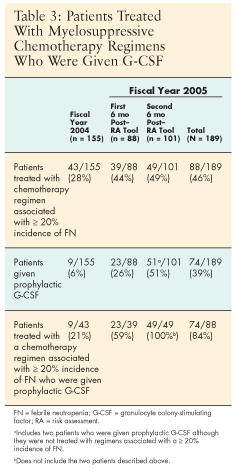
When data from the first 6 months of FY05 were compared to those from the second 6 months, an increase in the use of prophylactic G-CSF support was observed: from 26% (23/88) to 51% (51/101) in all patients (Figure 4) and from 59% (23/39) to 100% (49/49) in patients treated with regimens associated with a risk of FN ≥ 20% (Table 3). The number of patients treated with chemotherapy regimens associated with a risk of FN ≥ 20% for these two periods were 44% (39/88) and 49% (49/101), respectively.

It should be noted that in the second half of FY05, based on clinical judgment, G-CSF was considered necessary for two additional patients who were not treated with chemotherapy regimens associated with a risk of FN ≥ 20%: a patient who had a number of comorbidities, including diabetes, and a heavily treated patient who had developed neutropenia resulting in dose delays after treatment with regimens that were associated with a risk of FN < 20%.
The use of G-CSF for secondary prophylaxis (for patients who were not given growth factor in the first cycle of chemotherapy and who developed neutropenia defined as ANC < 1,500/µL between cycles) was also studied. Secondary prophylaxis with G-CSF decreased from 12% (18/155) in FY04 to 10% (9/88) in the first 6 months of FY05 to 6% (6/101) in the second 6 months of FY05 (see Figure 4).
Benefits of Risk Assessment Tool Implementation
This study shows the potential benefit of routine and systematic evaluation of patients by nurses using a risk assessment tool for FN. In our study, the implementation of the risk assessment tool significantly reduced the number of hospitalizations for FN by 78%, from 9.7% of all patients in 2004 (before the implementation of the tool) to 2.1% of all patients in 2005 (P = .003). The total number of hospital days also decreased, from 117 in 2004 to 24 in 2005, and the average length of hospital stay decreased from 7.8 to 6 days in the respective periods.
This study also validates the use of a risk assessment tool that is consistent with national evidence-based guidelines as an appropriate method to improve patient outcomes. It should be noted that the NCCN guidelines did not become available until 6 months after our project was initiated[27]; the most recent ASCO and EORTC guidelines were published earlier this year, after the completion of our study.[28,29]
It is perhaps not surprising that prophylactic use of G-CSF increased after patient risk of FN began to be assessed systematically. We found that its use was restrained and appropriate. Of the 189 patients assessed in FY05, only 74 (39%) were considered eligible for prophylactic G-CSF, even though many others had risk factors for FN (Table 2). As suggested by all the guidelines, the use of G-CSF was considered for all patients with risk factors who were not treated with a myelosuppressive chemotherapy regimen associated with a ≥ 20% risk of FN.[27] Based on clinical judgment, two patients were given G-CSF although they were treated with chemotherapy regimens associated with a risk of FN < 20%.
The implementation of this tool enabled nursing staff to assess all patients who were initiating chemotherapy and to appropriately identify those at approximately 20% risk of FN. Because the nursing staff became more familiar with the regimens that are associated with ≥ 20% risk of FN, use of G-CSF increased between the first 6 months after implementation of the tool and the second 6-month period. The NCCN,[27] ASCO,[28] and EORTC[29] guidelines are a good source of guidance on the myelotoxicity of common chemotherapy regimens.
The implementation of a risk assessment tool requires acceptance from other members of the multidisciplinary team, as well as commitment on their part to support the project. In our clinic, the physicians and midlevel providers saw the potential for reducing hospitalizations due to FN, and they supported this nurse-driven quality improvement study from its inception. Nurses found the tool simple and easy to use. The patient evaluation forms were given to the midlevel providers, who entered orders for G-CSF on the chemotherapy order form for appropriate patients. Because the order for G-CSF was integrated into the treatment plan based on a pretreatment risk assessment, nurses were able to plan an individualized education session about self-injection for appropriate patients, and this promoted more efficient use of patients' and providers' time.
Since the time of our study, we have developed an electronic template for risk assessment, and we are now able to capture our findings in the existing electronic medical records. As recommended by the NCCN guidelines,[27] a patient's risk of FN is now reassessed before every cycle of chemotherapy.
Related Study
In a study similar to ours, Donohue et al found that patient outcomes improved after a simple tool was used to assess the risk of neutropenic complications.[30] A nurse, nurse practitioner, or physician assessed patients before the first and all subsequent cycles of chemotherapy for the presence or absence of the following risk factors: regimen with ≥ 40% risk of FN, age ≥ 70 years with combination chemotherapy, bone marrow involvement or compromise, open wounds, history of FN, first-cycle ANC ≤ 500/µL, or serum albumin level ≤ 3.5 g/dL. Patients who presented with one of the above factors were determined to be at risk for FN and were given G-CSF in all subsequent cycles, at which point no further risk assessment was performed.
A chart review showed that of the 35 patients treated in 2003, after implementation of the tool, 72% received CSF compared with 28% of the 50 patients who were treated without the tool in 2000 (P < .001). Patients assessed and managed with the tool had a lower risk of FN, hospitalization for FN, treatment with intravenous antibiotics, chemotherapy dose delays, and chemotherapy dose reductions. The differences were clinically significant for all endpoints and the difference was statistically significant for dose delays (required for 9% of patients in 2003 vs 32% in 2001, P = .01).
Several other hospitals and cancer clinics have developed protocols for preventing FN that recognize the nurse's role in risk assessment and the importance of communication among members of the multidisciplinary team.[31] Although the risk assessment tool that was implemented differed from center to center, all of these teams observed a reduction in chemotherapy dose delays and dose reductions after nurses became involved in patient evaluation.
Possible Study Limitations
Our study was undertaken as a quality improvement pilot project and is limited by the relatively small number of subjects. Only 6% of the patients treated during FY04 and 4% of those treated during FY05 were female, which is representative of the VA population but not other community populations. The two groups were also atypical of the general community with regard to the low prevalence of prostate and breast cancer (Table 1), the most common tumor types in the United States.[32] Support for this project in our clinic was facilitated by our small clinic size and well-established working relationships with the midlevel providers and physicians.
Another potential limitation of the study is the fact that the comparison group was treated a year earlier than the patients who were evaluated with the risk assessment tool, rather than concurrently. However, there was no change between the two periods in how cancer regimens were chosen, patient education, or patient monitoring for neutropenia. Thus, we conclude that the improved outcomes are attributable to the implementation of the risk assessment tool.
Our goals for the future are to complete the risk assessment tool for all cancer patients receiving treatment both in the Cancer Care Clinic and inpatient medical oncology unit in the Puget Sound VA system to investigate the effect of risk assessment on chemotherapy dose delays and reductions, and to develop an algorithm that will ensure appropriate follow-up after a patient's risk of FN has been identified.
Too often, quality improvement projects are considered "necessary evils," completed only to satisfy requirements. This study serves as a model of how oncology nurses can bring about change in clinical systems, influence the actions of multidisciplinary teams, and improve patient outcomes.
Conclusions
Neutropenic complications in cancer patients are associated with suboptimal delivery of chemotherapy, substantial morbidity, and mortality. According to three recently published guidelines, patients at risk of FN or other neutropenic complications should be identified before chemotherapy is initiated so they can receive primary prophylaxis with G-CSF. Implementing a risk assessment tool, such as the one presented here, allows oncology nurses to evaluate patient risk for FN by considering the risk associated with the chemotherapy regimen and patient-specific risk factors. Targeted G-CSF support for appropriate patients can lead to improved outcomes, such as a reduction in FN-related hospitalizations.
References:
1. Bodey GP, Buckley M, Sathe YS, et al: Quantitative relationships between circulating leukocytes and infection in patients with acute leukemia. Ann Intern Med 64:328-340, 1966.
2. Crawford J, Dale DC, Lyman GH: Chemotherapy-induced neutropenia: Risks, consequences, and new directions for its management. Cancer 100:228-237, 2004.
3. Hughes WT, Armstrong D, Bodey GP, et al: 2002 guidelines for the use of antimicrobial agents in neutropenic patients with cancer. Clin Infect Dis 34:730-751, 2002.
4. Caggiano V, Weiss RV, Rickert TS, et al: Incidence, cost, and mortality of neutropenia hospitalization associated with chemotherapy. Cancer 103:1916-1924, 2005.
5. Kuderer NM, Dale DC, Crawford J, et al: Mortality, morbidity, and cost associated with febrile neutropenia in adult cancer patients. Cancer 106:2258-2266, 2006.
6. Epelbaum R, Faraggi D, Ben-Arie Y, et al: Survival of diffuse large cell lymphoma. A multivariate analysis including dose intensity variables. Cancer 66:1124-1129, 1990.
7. Kwak LW, Halpern J, Olshen RA, et al: Prognostic significance of actual dose intensity in diffuse large-cell lymphoma: results of a tree-structured survival analysis. J Clin Oncol 8:963-977, 1990.
8. Lepage E, Gisselbrecht C, Haioun C, et al: Prognostic significance of received relative dose intensity in non-Hodgkin's lymphoma patients: Application to LNH-87 protocol. The GELA (Groupe d'Etude des Lymphomes de l'Adulte). Ann Oncol 4:651-656, 1993.
9. Bonadonna G, Valagussa P, Moliterni A, et al: Adjuvant cyclophosphamide, methotrexate, and fluorouracil in node-positive breast cancer: The results of 20 years of follow-up. N Engl J Med 332:901-906, 1995.
10. Budman DR, Berry DA, Cirrincione CT, et al: Dose and dose intensity as determinants of outcome in the adjuvant treatment of breast cancer. The Cancer and Leukemia Group B. J Natl Cancer Inst 90:1205-1211, 1998.
11. Citron ML, Berry DA, Cirrincione C, et al: Randomized trial of dose-dense versus conventionally scheduled and sequential versus concurrent combination chemotherapy as postoperative adjuvant treatment of node-positive primary breast cancer: First report of Intergroup Trial C9741/Cancer and Leukemia Group B Trial 9741. J Clin Oncol 21:1431-1439, 2003.
12. Ardizzoni A, Favaretto A, Boni L, et al: Platinum-etoposide chemotherapy in elderly patients with small-cell lung cancer: results of a randomized multicenter phase II study assessing attenuated-dose or full-dose with lenograstim prophylaxis-A Forza Operativa Nazionale Italiana Carcinoma Polmonare and Gruppo Studio Tumori Polmonari Veneto (FONICAP-GSTPV) study. J Clin Oncol 23:569-575, 2005.
13. Bonneterre J, Roche H, Kerbrat P, et al: Epirubicin increases long-term survival in adjuvant chemotherapy of patients with poor-prognosis, node-positive, early breast cancer: 10-year follow-up results of the French Adjuvant Study Group 05 randomized trial. J Clin Oncol 23:2686-2693, 2005.
14. Fortner BV, Stolshek B, Tauer KW, et al: Final analysis: Chemotherapy-induced neutropenia is associated with lower quality of life in patients with cancer (abstract 640P). Presented at the 27th ESMO Congress, Nice, France, 18-22 October 2002. Ann Oncol 13(suppl 5):174, 2002.
15. Okon TA, Fortner BV, Schwartzberg L, et al: Quality of life (QOL) in patients with grade IV chemotherapy-induced neutropenia (abstract 2920). Proc Am Soc Clin Oncol 21:275b, 2002.
16. Padilla G, Ropka ME: Quality of life and chemotherapy-induced neutropenia. Cancer Nurs 28:167-171, 2005.
17. Lyman GH, Kuderer NM: Filgrastim in patients with neutropenia: Potential effects on quality of life. Drugs 62(suppl 1):65-78, 2002.
18. Crawford J, Ozer H, Stoller R, et al: Reduction by granulocyte colony-stimulating factor of fever and neutropenia induced by chemotherapy in patients with small-cell lung cancer. N Engl J Med 325:164-170, 1991.
19. Pettengell R, Gurney H, Radford JA, et al: Granulocyte colony-stimulating factor to prevent dose-limiting neutropenia in non-Hodgkin's lymphoma: A randomized controlled trial. Blood 80:1430-1436, 1992.
20. Trillet-Lenoir V, Green J, Manegold C, et al: Recombinant granulocyte colony stimulating factor reduces the infectious complications of cytotoxic chemotherapy. Eur J Cancer 29A:319-324, 1993.
21. Holmes FA, O'Shaughnessy JA, Vukelja S, et al: Blinded, randomized, multicenter study to evaluate single administration pegfilgrastim once per cycle versus daily filgrastim as an adjunct to chemotherapy in patients with high-risk stage II or stage III/IV breast cancer. J Clin Oncol 20:727-731, 2002.
22. Green MD, Koelbl H, Baselga J, et al: A randomized double-blind multicenter phase III study of fixed-dose single-administration pegfilgrastim versus daily filgrastim in patients receiving myelosuppressive chemotherapy. Ann Oncol 14:29-35, 2003.
23. Vogel CL, Wojtukiewicz MZ, Carroll RR, et al: First and subsequent cycle use of pegfilgrastim prevents febrile neutropenia in patients with breast cancer: A multicenter, double-blind, placebo-controlled phase III study. J Clin Oncol 23:1178-1184, 2005.
24. Kuderer NM, Crawford J, Dale DC, et al: Meta-analysis of prophylactic granulocyte colony-stimulating factor in cancer patients receiving chemotherapy (abstract 8117). J Clin Oncol 23(16S):758s, 2005.
25. de Graaf H, Willemse PH, Bong SB, et al: Dose intensity of standard adjuvant CMF with granulocyte colony-stimulating factor for premenopausal patients with node-positive breast cancer. Oncology (Basel) 53:289-294, 1996.
26. Siena S, Piccart MJ, Holmes FA, et al: A single dose of pegfilgrastim per chemotherapy cycle allows most patients to receive an average relative dose intensity (ARDI) ≥ 85% (abstract 535). Breast Cancer Res Treat 76(suppl 1):S134, 2002.
27. Crawford J, Althaus B, Armitage J, et al: Myeloid growth factors clinical practice guidelines in oncology. J Natl Compr Canc Netw 3:540-555, 2005.
28. Smith TJC, Khatcheressian J, Lyman GH, et al: 2006 update of recommendations for the use of white blood cell growth factors: An evidence-based clinical practice guideline. J Clin Oncol 24:3187-3205, 2006.
29. Aapro MS, Cameron DA, Pettengell R, et al, for the European Organisation for Research and Treatment of Cancer (EORTC) Granulocyte Colony-Stimulating Factor (G-CSF) Guidelines Working Party: EORTC guidelines for the use of granulocyte-colony stimulating factor to reduce the incidence of chemotherapy-induced febrile neutropenia in adult patients with lymphomas and solid tumours. Eur J Cancer May 31, 2006 [e-pub ahead of print].
30. Donohue R: Development and implementation of a risk assessment tool for chemotherapy-induced neutropenia. Oncol Nurs Forum 33:347-352, 2006.
31. White N, Maxwell C, Michelson J, et al: Protocols for managing chemotherapy-induced neutropenia in clinical oncology practices. Cancer Nurs 28:62-69, 2005.
32. Jemal A, Siegel R, Ward E, et al: Cancer statistics, 2006. CA Cancer J Clin 56:106-130, 2006.
Oncology Peer Review On-The-Go: Cancer-Related Fatigue Outcome Measures in Integrative Oncology
September 20th 2022Authors Dori Beeler, PhD; Shelley Wang, MD, MPH; and Viraj A. Master, MD, PhD, spoke with CancerNetwork® about a review article on cancer-related fatigue published in the journal ONCOLOGY®.